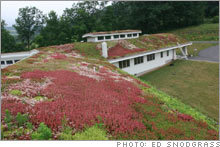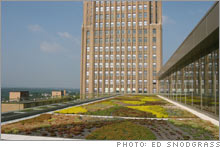NEW YORK (CNNMoney.com) -- With American's newfound concern over global warming, and the age old desire to stretch the dollar as far as it can go, more and more buildings are going green, literally.
The number of buildings with green roofs - rooftops covered in hearty plants like sedum and prairie grass - grew 25 percent last year, according to the industry association Green Roofs for Healthy Cities.
 |
| A green roof at the Life Expressions Wellness Center in Hazelton, Pa. |
 |
| Adding some color at the PPL Plaza in Allentown, Pa., headquarters for Pennsylvania Power and Light. |
Moreover, building with intensive green roofs, which generally have larger plants or grasses as opposed to the groundcover-like sedum or other succulents, increased by 110 percent.
The numbers are still small. Leslie Hoffman, executive director of the sustainable development organization Earth Pledge, said 300 roofs went green in the U.S. last year, the average of which was 5000 square feet.
Easing the burden on the environment is partly driving this trend. Experts say a green roof can save up to 10 percent on a building's energy costs, mostly by keeping it cool during the summer and reducing the burden on air conditioners.
Plant-covered roofs also help absorb carbon dioxide from the atmosphere, reduce the effect of radiant heating from cities, ease the burden on city storm water systems by drastically absorbing rain water runoff, and can boost the efficiency of solar panels by 15 percent.
Cost is a big barrier for many people.
Christian Werthmann, a Harvard landscape architecture professor, said a basic green roof, using just succulents and rocks, can cost as little as $6 a square foot, and go up from there.
A big reason landlords decide to green up a rooftop is structural: protective plants and the material they grow in can more than double a roof's lifetime, Werthmann said at a recent green roofs conference at the New York Botanical Garden.
Installing a green roof is not an easy, endeavor. Obviously, putting a bunch of moist dirt up on your roof isn't a good idea.
So the green roof's systems are carefully engineered. They use lightweight growing medium, typically light on organic rich "dirt" and mostly made up of mineral matter like rocks or shale.
Drainage and, if necessary, irrigation systems are installed. The plants are chosen based on the regional environment and situated to thrive in the specific light conditions of the roof.
It's all designed to be as maintenance free as possible.
Werthmann showcased a pricey rooftop that had a final price tag of $110 per square foot.
But this expensive space had ample room for people to gather, employing aluminum grates over sections of the roof, under which lay the plants.
"It's a social space," he said. "You can step out there and get some fresh air, bring a drink up there, have lunch."
It's not just building occupants that are said to benefit from added greenery.
Ed Snodgrass, owner and president of Emory Knoll Farms and Green Roof Plants, said a recent study by the University of Illinois showed a big drop in domestic violence and juvenal delinquency in places that had re-greened, not just with rooftops but the neighborhood at large.
"We have an inherent connection with nature," said Snodgrass. "When that gets taken away, we get troubled."
_________________
As climate worries grow, cities turn green
ConocoPhillips: The anti-Exxon 